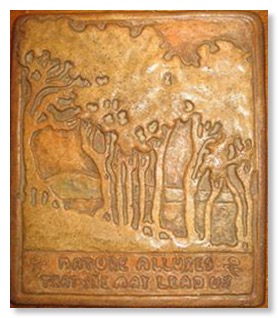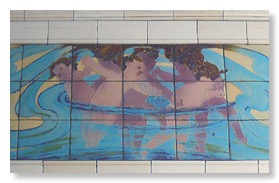E-News for Winter 2012
06/03/12 15:58 Filed in: E-News
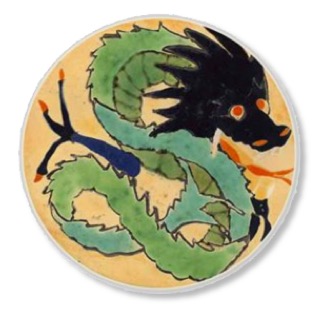
Year of the Dragon
Here’s Who We Are
Dragons Extracted from Fire
Majestic Facade Preserved
Handcraft Revival
Swimming Pool Restoration
Notes on Batchelder’s Backs
Hamilton Pottery: New Discovery
Historic Tile Lectures at NCECA
Buss Wins Tile Heritage Prize
ATNW Tile Festival
Tile Maker Directories
Payne Creations
The Year of the Dragon TheTile Heritage Foundation celebrates the Year of the Dragon! We invited our members to send us images of dragon tiles, and each month we will post a new dragon as “Tile of the Moment.” A pdf of all the dragons is available with our compliments! Click here and enjoy! The image above is an 8 inch circular dragon tile from Mission San Jose, San Antonio, Texas, circa 1950’s. Designed by Fernando Ramos. Collection of Susan Frost.
The legend of the Chinese Dragon permeates the ancient Chinese civilization. Dragons are referred to as the divine mythical creature that brings with it ultimate abundance, prosperity and good fortune. Its benevolence signifies greatness, goodness and blessings.
The Dragon is one of the 12-year cycles of animals that appear in the Chinese zodiac related to the Chinese calendar and the only animal that is legendary. The Year of the Dragon is considered the luckiest year: 23 January 2012 - 9 February 2013.
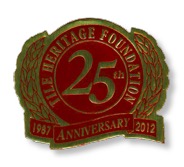 E-News in Print - this issue . .
E-News in Print - this issue . .
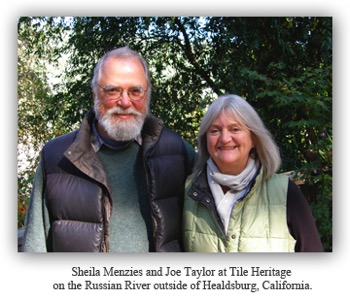 Here’s Who We Are *
Here’s Who We Are *
The co-founders of the Tile Heritage Foundation, Sheila Menzies and Joseph Taylor, have been at it for 25 years, a long time to be studying tiles and providing free information on historical and preservation issues to both the industry and the public. The couple is responsible for running the organization, a designated 501(c)(3) nonprofit, manning the library and archives and maintaining the collections, presumed to be the largest collection of U.S. decorative and glazed tiles in the public domain. The collections, library and archives are open to the public by appointment.
* See Jeffrey Steele’s “One-on-One” interview with Sheila and Joe in Tile Dealer online.
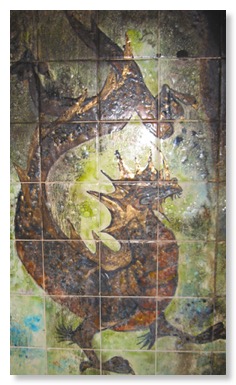 Dragons Extracted from the Fire
Dragons Extracted from the Fire
On December 12, 2011 a fire of unknown origin consumed the rear of the Adelaide Tichenor House in Long Beach, California. The house was designed by architects Greene & Greene and built in 1904-05. The house was remodeled in 1953 by architect Adrian Wilson, and it seems likely that the dragon (in fact, a pair of dragons) created by artist J. Nison was installed in the back bathroom shower wall at that time. Interestingly, the house was built in the Year of the (Wood) Dragon and remodeled in the Year of the (Water) Dragon.
The home owner, terribly distraught from his loss, called the Tile Heritage Foundation for a brief consultation. We recommended that he contact Brian Kaiser in nearby South Gate to evaluate the installation and potentially remove the tiles. Brian has been in close contact ever since. Read more about Brian.
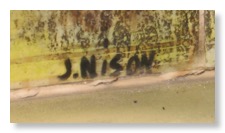 On Feb 14, 2012, at 12:00 AM, Brian Kaiser wrote:
On Feb 14, 2012, at 12:00 AM, Brian Kaiser wrote:
“I started the Dragon mural in Long Beach today. This is going to be a nightmare. Mortar bed is as hard as iron, and very thick. Tile clay body is very, very brittle and weak. Grout lines are almost non-existent, and I cannot work from the back. I will have to take slabs of the entire wall, right down to the studs.”
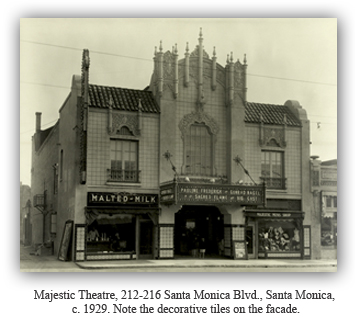 Majestic Facade Preserved
Majestic Facade Preserved
We understand from Diana Mausser at Native Tile & Ceramics in Torrance, California, that the facade of the old Majestic (now Mayfair) Theatre in Santa Monica is likely to be restored—not the building, which was destroyed in the 1994 North-ridge quake, just the facade. Diana was approached by Preservation Arts, a full service historic preservation company in LA, to identify the decorative tiles on the facade from a 1929 photograph as the tiles have been long since removed. She contacted Tile Heritage for our opinion.
Zooming in on the picture gives a good, if blurry, conception... Gladding, McBean (Tropico Potteries). The reason stems from the "flavor" of the decorative tiles and their combination with the glossy black 4 1/4 tiles. GMB, producing both, had an advantage over the few other companies that might be candidates.
The Majestic Theatre was designed as a silent movie house by architect Henry Hollwedel in 1911. The owner, Charles Tegner, was one of the early pioneers of this bayside community that then numbered about 1000 residents. The building was renovated several times over the years, suffering through a number of different tenants, until Karl Schober, Tegner’s grandson, assumed control just three days prior to the devastating earthquake in 1994. As what’s left of the building has landmark status, the current architect, David Hibbert, is challenged to incorporate the old facade into a newly designed mixed-use structure.
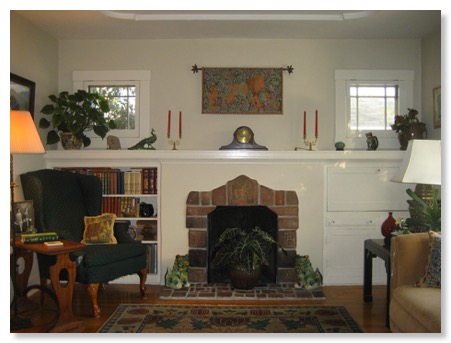 Handcraft Revival
Handcraft Revival
A homeowner in San Jose, California wrote: “A few years ago I was lucky enough to find a full fireplace set of vintage Handcraft tiles for sale. We had Riley Doty install them in our 1928 house and are quite pleased.”
Handcraft tiles are now produced by Malibu Ceramic Works in Topanga, California. See www.handcrafttiles.com
Swimming Pool Restoration at the Berkeley City Club
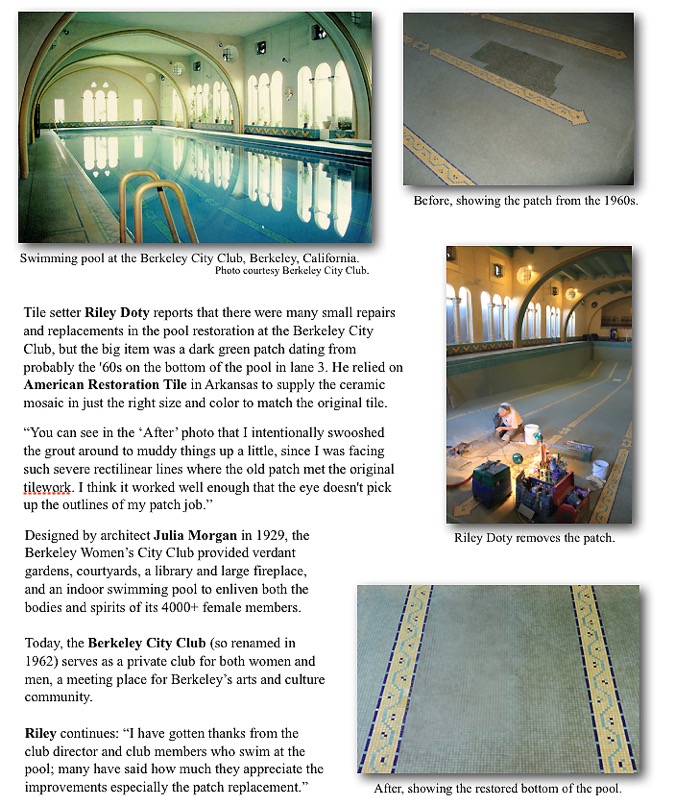
Links to Riley Doty, American Restoration Tile and Berkeley City Club
Notes on the Marks on the Backs of Batchelder Field Tiles
From Kirby William Brown, Nov. 21, 2011 (updated Jan. 3, 2012)
To view larger images in a PDF click here
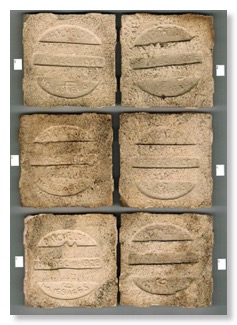 I recently obtained a little collection of 23 3” x 3” Batchelder field tiles all with apparently the same Pat. 1928 stamp. After cleaning them my eye was caught by some anomalies on the back stamps and I ended up counting 19 different varieties out of the 23 tiles. The anomalies are added triangular markers and numbers in various positions.
I recently obtained a little collection of 23 3” x 3” Batchelder field tiles all with apparently the same Pat. 1928 stamp. After cleaning them my eye was caught by some anomalies on the back stamps and I ended up counting 19 different varieties out of the 23 tiles. The anomalies are added triangular markers and numbers in various positions.
1. Top part unmodified; bottom with sideways “4” above “46”
2. Top part unmodified; bottom with weak sideways “7” above “94”.
3. Top part unmodified; bottom with “+” above first “1”, sideways “3” above “94”.
4. Top part unmodified; bottom with strong sideways “5” above “94”.
5. Top with 1 pointer to “HE” & 1 pointer to “L”; bottom with sideways “9” above “94”. [1 duplicate]
6. Top part unmodified; bottom with sideways “9” above “94”.
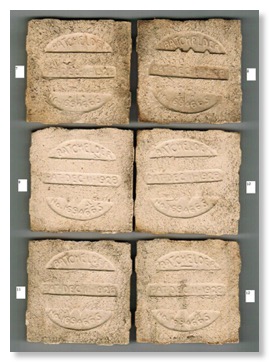 7. Top part unmodified; bottom with vertical line between “9” & “4” with 3 dots.
7. Top part unmodified; bottom with vertical line between “9” & “4” with 3 dots.
8. Top with 1 pointer to “T”, 1 pointer to “HE”, 1 pointer to “D”; bottom with vertical line between “9” & “4” with 4 dots. [1duplicate]
9. Top with sideways “2” below “D”; bottom with 1 pointer to “6”, 1 pointer to “9” and sideways “2” above “66”.
10. Top part unmodified; bottom with sideways “7” above “16”, 1 pointer to “69”, and 1 pointer to “6”. [1 duplicate]
11. Top with sideways “2” below “D”; bottom with sideways “2” above first “1”, 1 pointer to “6”, and 1 pointer to “4”.
12. Top part with horizontal line with 2 dots at ends below “HE”; bottom with 1 pointer to “6”, 1 pointer to “4” and diagonal line with 2 dots above “65”
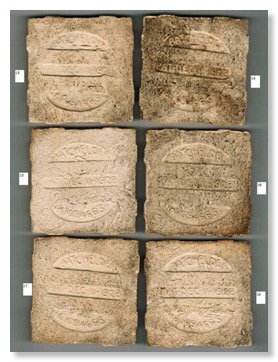 13. Top with horizontal line with 2 dots at ends below “EL”, ; bottom with vertical line and 2 dots above first “1”, 1 pointer to “9”, and 1 pointer to 4.
13. Top with horizontal line with 2 dots at ends below “EL”, ; bottom with vertical line and 2 dots above first “1”, 1 pointer to “9”, and 1 pointer to 4.
14. Top with horizontal line with 2 dots at ends below “CHE”,; bottom with diagonal line with 2 dots to left of first “1”, 1 pointer to “6”, 1 pointer to “4”.
15. Top with sideways “2” below “HE”; bottom with 1 pointer to “69”, 1 pointer to “46”.
16. Top with sideways “2” below “EL”; bottom with 1 pointer to “6”, 1 pointer to “94” and sideways “2” above 66. [1 duplicate]
17. Top part unmodified; bottom with sideways “4” above “No.”, 1 pointer to “6”, 1 pointer to “94” and sideways “4” above “66.
18. Top part with 4 vertical lines below “ELD”; bottom with sideways “4” above “No.”, 1 pointer to “6”, 1 pointer to “94” and sideways “4” above “66.
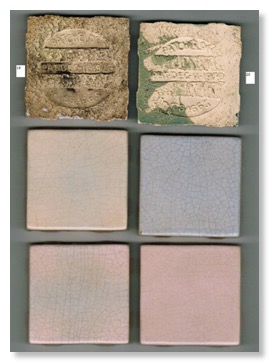 19. Top part with “4” under “CH”, bottom part with “4” above “94”.
19. Top part with “4” under “CH”, bottom part with “4” above “94”.
20. Stock stamp with no modification [on a tile not part of above set].
This might seem like something totally insignificant, but I get intrigued by this sort of thing. The numbers and marks were clearly added to the back stamp and probably are some sort of control or batch identification mark. There is no correlation with glazes, most of the tiles are pale pinkish, a few more towards violet and some gray. The symbols had to be cut into the master mold from which the back stamp was made. California Faience Company had back stamps made of plaster and also fired clay. I am curious if any Batchelder enthusiasts are familiar with these markings. Please contact me through Tile Heritage at foundation@tileheritage.org Kirby Brown
Hamilton Pottery: A Recent Discovery!
From Steve Soukup, mid-January 2012
I have attached some photographs recently acquired of a California tile made by the Hamilton Pottery of Culver City (1916-1930). The pottery and tile company was started and operated by Minerva Hamilton and her two daughters May and Vieve (short for Genevieve). The impressed mark reads “MAVIVA WARE” which appears to be an acronym derived from MAy’s, VIeve’s, and MinerVA’s first names. While I have located a few tile mantle installations credited to Hamilton tiles, this is only the second loose tile I have seen and the first with such marks. The Hamilton sisters have been a research subject of mine for many, many years and it has been very slow going. They were most well known for their later art deco style ceramics produced first at the Sebring Pottery around 1933-34 and later by Vernon Kilns in Los Angeles around 1937-39. Some of their bowls, vases and sculptures were awarded in the early Syracuse National ceramic exhibitions.
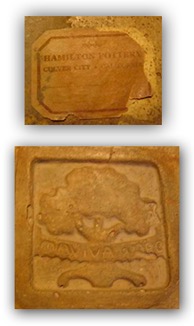
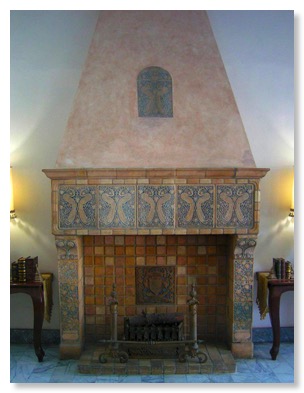 The fireplace tiles in the main lobby at the Sovereign Hotel, 360 West Ocean in Long Beach, built in 1922, were misidentified as “Batchelder” in the EIR (Environment Impact Report) done for the property. The tiles were made by Hamilton Pottery/Hamilton Tiles Inc. of Culver City. I have to believe, given that Hamilton was in business for 14 years, that there are probably dozens of examples of its work that have been similarly misidentified.
The fireplace tiles in the main lobby at the Sovereign Hotel, 360 West Ocean in Long Beach, built in 1922, were misidentified as “Batchelder” in the EIR (Environment Impact Report) done for the property. The tiles were made by Hamilton Pottery/Hamilton Tiles Inc. of Culver City. I have to believe, given that Hamilton was in business for 14 years, that there are probably dozens of examples of its work that have been similarly misidentified.
Rookwood Arts & Crafts Tiles: From Cincinnati to Seattle. Richard Mohr
Tuesday, March 27, 2012, 7-9 p.m.
Episcopal Diocese (Leary Mansion)
1551 10th Avenue E., Capitol Hill, Seattle
Gen: $20; Historic Seattle member: $15; Student: $5.
Call Historic Seattle for reservations: 206 622-6952 or REGISTER HERE.
Art tiles by the Rookwood Pottery of Cincinnati (1880-1960) had a considerable presence in Seattle during the peak years of their production. Rookwood fireplace surrounds were installed in the Leary Mansion (1904-1907), the Sorrento Hotel (1908-1909), and the New Washington Hotel (1908). Rookwood won grand prize at the 1909 Alaska-Yukon-Pacific Exposition and its tiles were available for domestic use through the tile showrooms of Seattle’s William W. Kellogg. Drawing on archival sources, this lecture explores the origins, designers, techniques and styles of Rookwood faience tiles. It is based on a three-part study published in the Journal of the American Art Pottery Association. Richard Mohr holds degrees from the University of Chicago and the University of Toronto. He is Professor Emeritus of Philosophy at the University of Illinois Urbana-Champaign. Richard has become known for writings on the decorative arts and architecture that have appeared in Architectural Record, Art Issues, American Bungalow, theJournal of the American Art Pottery Association, Tabby, the publication of the Arts & Crafts Press, and Flash Point, the publication of the Tile Heritage Foundation. He is author of Pottery, Politics, Art: George Ohr and the Brothers Kirkpatrick.
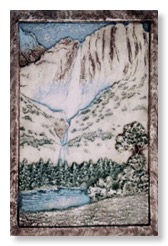 Creating Beauty from the Earth: California Decorative Tiles, 1910-1930. Joseph Taylor
Creating Beauty from the Earth: California Decorative Tiles, 1910-1930. Joseph Taylor
Wednesday, March 28, 2012, 4-5:30 p.m.
at Tuscany Apartments cafeteria, 1215 Seneca St., Seattle WA 98101
General: $20; Historic Seattle member: $15; Student: $5.
Call Historic Seattle for reservations: 206 622-6952 or REGISTER HERE.
Witness the development of decorative tile manufacturing in California from its inception in 1910 through its heyday in the 1920s to its culmination during the dark days of the Great Depression. At the turn of the last century California tile makers an extraordinary mix of talent, ushered in two new and distinctly different aesthetics, each of which captured the imagination of architects and designers throughout the state and, eventually, the rest of the country. The handcrafted tiles with muted, matte finishes of the Arts & Crafts era and designs inspired from the Middle Ages in Europe presented a sharp contrast to the bright glazes and geometric designs derived primarily from Moorish, Spanish and Mexican sources. Both aesthetics had a profound and lasting effect, enhancing the popular architectural styles of the period and influencing ceramic tile makers today. Joseph A. Taylor, a writer and educator, is co-founder and current president of the Tile Heritage Foundation, the mission of which is to research and preserve the tile traditions in the United States. In addition to his administrative responsibilities, he has served as the editor of the Foundation’s publications for the past 24 years. A frequent writer and lecturer on tile history, Taylor was a principal contributor and editor for California Tile: The Golden Era 1910-1940 published by Schiffer in 2004. He was initiated into the world of tiles when he worked at McIntyre Tile Company in Healdsburg, California in the 1970s.
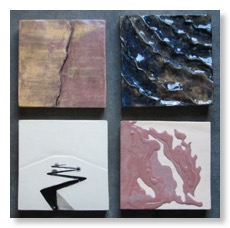 Tile Heritage Prize 2011
Tile Heritage Prize 2011
"Signs of the End Times" by Mary Lynn Buss won the Tile Heritage Prize at the ATNW Tile Festival in Seattle in October 2011. Clockwise from top left the tiles are titled Subduction, Tsunami, Liquifaction, and Quake Crack.
Mary Lynn Buss, whose Isle Tile is located on Vashon Island, specializes in original low relief tiles and murals. Her greatest passion is for doing domestic, commercial, and public commissions.
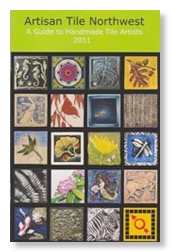
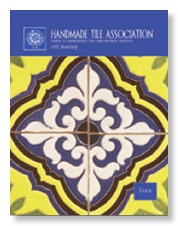
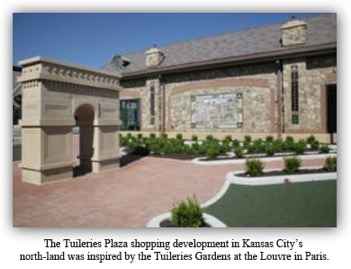 Payne Creations in Kansas City
Payne Creations in Kansas City
Carolyn Payne, a tile talent in Kansas City and a longtime member of Tile Heritage, wrote recently that she had launched her first video on her hand-painted tile, “just a fun generic 101 to be followed by more specific videos on different projects.” See her youtube posting.
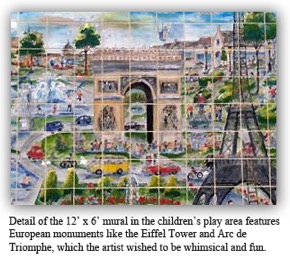 “Payne Creations Tile started in 1984, as I had long dreamed of achieving excellence in a specialized art medium that would lead to self-employment as an artist. I started in a two-bedroom, second-floor apartment. I used tile to depict historical scenes of Kansas City though a unique process I developed of silk screening glass glazes. I designed and glazed the tiles, then ran a few blocks to the basement of a friend¹s house where I had my first kilns. After making trips back and forth to the kilns, carrying tiles up and down two flights of stairs, I soon wished I had picked a lighter medium.”
“Payne Creations Tile started in 1984, as I had long dreamed of achieving excellence in a specialized art medium that would lead to self-employment as an artist. I started in a two-bedroom, second-floor apartment. I used tile to depict historical scenes of Kansas City though a unique process I developed of silk screening glass glazes. I designed and glazed the tiles, then ran a few blocks to the basement of a friend¹s house where I had my first kilns. After making trips back and forth to the kilns, carrying tiles up and down two flights of stairs, I soon wished I had picked a lighter medium.”
Today Carolyn works from her home in a 1500 sq. ft. art studio. Her work includes tile murals, restoration projects, signage, accent tiles, donor walls and gift tiles.
See who Sponsors Tile Heritage Foundation
Link to a PRINT VERSION of this E-News Link to E-News prior to Spring 2010
Calendar and Upcoming Events
E-News is available regularly to Tile Heritage members and friends.
If your email address has changed, please e-mail from the address you would like us to use.
foundation@tileheritage.org
Not a current THF member? Join us!

The legend of the Chinese Dragon permeates the ancient Chinese civilization. Dragons are referred to as the divine mythical creature that brings with it ultimate abundance, prosperity and good fortune. Its benevolence signifies greatness, goodness and blessings.
The Dragon is one of the 12-year cycles of animals that appear in the Chinese zodiac related to the Chinese calendar and the only animal that is legendary. The Year of the Dragon is considered the luckiest year: 23 January 2012 - 9 February 2013.


The co-founders of the Tile Heritage Foundation, Sheila Menzies and Joseph Taylor, have been at it for 25 years, a long time to be studying tiles and providing free information on historical and preservation issues to both the industry and the public. The couple is responsible for running the organization, a designated 501(c)(3) nonprofit, manning the library and archives and maintaining the collections, presumed to be the largest collection of U.S. decorative and glazed tiles in the public domain. The collections, library and archives are open to the public by appointment.
* See Jeffrey Steele’s “One-on-One” interview with Sheila and Joe in Tile Dealer online.

On December 12, 2011 a fire of unknown origin consumed the rear of the Adelaide Tichenor House in Long Beach, California. The house was designed by architects Greene & Greene and built in 1904-05. The house was remodeled in 1953 by architect Adrian Wilson, and it seems likely that the dragon (in fact, a pair of dragons) created by artist J. Nison was installed in the back bathroom shower wall at that time. Interestingly, the house was built in the Year of the (Wood) Dragon and remodeled in the Year of the (Water) Dragon.
The home owner, terribly distraught from his loss, called the Tile Heritage Foundation for a brief consultation. We recommended that he contact Brian Kaiser in nearby South Gate to evaluate the installation and potentially remove the tiles. Brian has been in close contact ever since. Read more about Brian.

“I started the Dragon mural in Long Beach today. This is going to be a nightmare. Mortar bed is as hard as iron, and very thick. Tile clay body is very, very brittle and weak. Grout lines are almost non-existent, and I cannot work from the back. I will have to take slabs of the entire wall, right down to the studs.”

We understand from Diana Mausser at Native Tile & Ceramics in Torrance, California, that the facade of the old Majestic (now Mayfair) Theatre in Santa Monica is likely to be restored—not the building, which was destroyed in the 1994 North-ridge quake, just the facade. Diana was approached by Preservation Arts, a full service historic preservation company in LA, to identify the decorative tiles on the facade from a 1929 photograph as the tiles have been long since removed. She contacted Tile Heritage for our opinion.
Zooming in on the picture gives a good, if blurry, conception... Gladding, McBean (Tropico Potteries). The reason stems from the "flavor" of the decorative tiles and their combination with the glossy black 4 1/4 tiles. GMB, producing both, had an advantage over the few other companies that might be candidates.
The Majestic Theatre was designed as a silent movie house by architect Henry Hollwedel in 1911. The owner, Charles Tegner, was one of the early pioneers of this bayside community that then numbered about 1000 residents. The building was renovated several times over the years, suffering through a number of different tenants, until Karl Schober, Tegner’s grandson, assumed control just three days prior to the devastating earthquake in 1994. As what’s left of the building has landmark status, the current architect, David Hibbert, is challenged to incorporate the old facade into a newly designed mixed-use structure.

A homeowner in San Jose, California wrote: “A few years ago I was lucky enough to find a full fireplace set of vintage Handcraft tiles for sale. We had Riley Doty install them in our 1928 house and are quite pleased.”
Handcraft tiles are now produced by Malibu Ceramic Works in Topanga, California. See www.handcrafttiles.com
Swimming Pool Restoration at the Berkeley City Club

Links to Riley Doty, American Restoration Tile and Berkeley City Club
Notes on the Marks on the Backs of Batchelder Field Tiles
From Kirby William Brown, Nov. 21, 2011 (updated Jan. 3, 2012)
To view larger images in a PDF click here

1. Top part unmodified; bottom with sideways “4” above “46”
2. Top part unmodified; bottom with weak sideways “7” above “94”.
3. Top part unmodified; bottom with “+” above first “1”, sideways “3” above “94”.
4. Top part unmodified; bottom with strong sideways “5” above “94”.
5. Top with 1 pointer to “HE” & 1 pointer to “L”; bottom with sideways “9” above “94”. [1 duplicate]
6. Top part unmodified; bottom with sideways “9” above “94”.

8. Top with 1 pointer to “T”, 1 pointer to “HE”, 1 pointer to “D”; bottom with vertical line between “9” & “4” with 4 dots. [1duplicate]
9. Top with sideways “2” below “D”; bottom with 1 pointer to “6”, 1 pointer to “9” and sideways “2” above “66”.
10. Top part unmodified; bottom with sideways “7” above “16”, 1 pointer to “69”, and 1 pointer to “6”. [1 duplicate]
11. Top with sideways “2” below “D”; bottom with sideways “2” above first “1”, 1 pointer to “6”, and 1 pointer to “4”.
12. Top part with horizontal line with 2 dots at ends below “HE”; bottom with 1 pointer to “6”, 1 pointer to “4” and diagonal line with 2 dots above “65”

14. Top with horizontal line with 2 dots at ends below “CHE”,; bottom with diagonal line with 2 dots to left of first “1”, 1 pointer to “6”, 1 pointer to “4”.
15. Top with sideways “2” below “HE”; bottom with 1 pointer to “69”, 1 pointer to “46”.
16. Top with sideways “2” below “EL”; bottom with 1 pointer to “6”, 1 pointer to “94” and sideways “2” above 66. [1 duplicate]
17. Top part unmodified; bottom with sideways “4” above “No.”, 1 pointer to “6”, 1 pointer to “94” and sideways “4” above “66.
18. Top part with 4 vertical lines below “ELD”; bottom with sideways “4” above “No.”, 1 pointer to “6”, 1 pointer to “94” and sideways “4” above “66.

20. Stock stamp with no modification [on a tile not part of above set].
This might seem like something totally insignificant, but I get intrigued by this sort of thing. The numbers and marks were clearly added to the back stamp and probably are some sort of control or batch identification mark. There is no correlation with glazes, most of the tiles are pale pinkish, a few more towards violet and some gray. The symbols had to be cut into the master mold from which the back stamp was made. California Faience Company had back stamps made of plaster and also fired clay. I am curious if any Batchelder enthusiasts are familiar with these markings. Please contact me through Tile Heritage at foundation@tileheritage.org Kirby Brown
Hamilton Pottery: A Recent Discovery!
From Steve Soukup, mid-January 2012
I have attached some photographs recently acquired of a California tile made by the Hamilton Pottery of Culver City (1916-1930). The pottery and tile company was started and operated by Minerva Hamilton and her two daughters May and Vieve (short for Genevieve). The impressed mark reads “MAVIVA WARE” which appears to be an acronym derived from MAy’s, VIeve’s, and MinerVA’s first names. While I have located a few tile mantle installations credited to Hamilton tiles, this is only the second loose tile I have seen and the first with such marks. The Hamilton sisters have been a research subject of mine for many, many years and it has been very slow going. They were most well known for their later art deco style ceramics produced first at the Sebring Pottery around 1933-34 and later by Vernon Kilns in Los Angeles around 1937-39. Some of their bowls, vases and sculptures were awarded in the early Syracuse National ceramic exhibitions.


Rookwood Arts & Crafts Tiles: From Cincinnati to Seattle. Richard Mohr
Tuesday, March 27, 2012, 7-9 p.m.
Episcopal Diocese (Leary Mansion)
1551 10th Avenue E., Capitol Hill, Seattle
Gen: $20; Historic Seattle member: $15; Student: $5.
Call Historic Seattle for reservations: 206 622-6952 or REGISTER HERE.
Art tiles by the Rookwood Pottery of Cincinnati (1880-1960) had a considerable presence in Seattle during the peak years of their production. Rookwood fireplace surrounds were installed in the Leary Mansion (1904-1907), the Sorrento Hotel (1908-1909), and the New Washington Hotel (1908). Rookwood won grand prize at the 1909 Alaska-Yukon-Pacific Exposition and its tiles were available for domestic use through the tile showrooms of Seattle’s William W. Kellogg. Drawing on archival sources, this lecture explores the origins, designers, techniques and styles of Rookwood faience tiles. It is based on a three-part study published in the Journal of the American Art Pottery Association. Richard Mohr holds degrees from the University of Chicago and the University of Toronto. He is Professor Emeritus of Philosophy at the University of Illinois Urbana-Champaign. Richard has become known for writings on the decorative arts and architecture that have appeared in Architectural Record, Art Issues, American Bungalow, theJournal of the American Art Pottery Association, Tabby, the publication of the Arts & Crafts Press, and Flash Point, the publication of the Tile Heritage Foundation. He is author of Pottery, Politics, Art: George Ohr and the Brothers Kirkpatrick.

Wednesday, March 28, 2012, 4-5:30 p.m.
at Tuscany Apartments cafeteria, 1215 Seneca St., Seattle WA 98101
General: $20; Historic Seattle member: $15; Student: $5.
Call Historic Seattle for reservations: 206 622-6952 or REGISTER HERE.
Witness the development of decorative tile manufacturing in California from its inception in 1910 through its heyday in the 1920s to its culmination during the dark days of the Great Depression. At the turn of the last century California tile makers an extraordinary mix of talent, ushered in two new and distinctly different aesthetics, each of which captured the imagination of architects and designers throughout the state and, eventually, the rest of the country. The handcrafted tiles with muted, matte finishes of the Arts & Crafts era and designs inspired from the Middle Ages in Europe presented a sharp contrast to the bright glazes and geometric designs derived primarily from Moorish, Spanish and Mexican sources. Both aesthetics had a profound and lasting effect, enhancing the popular architectural styles of the period and influencing ceramic tile makers today. Joseph A. Taylor, a writer and educator, is co-founder and current president of the Tile Heritage Foundation, the mission of which is to research and preserve the tile traditions in the United States. In addition to his administrative responsibilities, he has served as the editor of the Foundation’s publications for the past 24 years. A frequent writer and lecturer on tile history, Taylor was a principal contributor and editor for California Tile: The Golden Era 1910-1940 published by Schiffer in 2004. He was initiated into the world of tiles when he worked at McIntyre Tile Company in Healdsburg, California in the 1970s.

"Signs of the End Times" by Mary Lynn Buss won the Tile Heritage Prize at the ATNW Tile Festival in Seattle in October 2011. Clockwise from top left the tiles are titled Subduction, Tsunami, Liquifaction, and Quake Crack.
Mary Lynn Buss, whose Isle Tile is located on Vashon Island, specializes in original low relief tiles and murals. Her greatest passion is for doing domestic, commercial, and public commissions.
Artisan Tile Northwest Tile Festival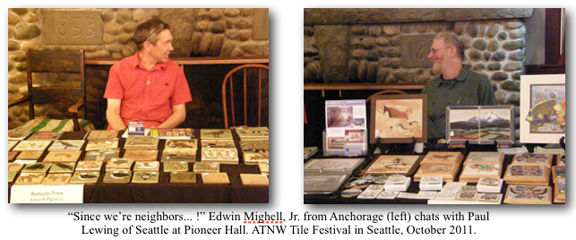


Tile Maker Directories Artisan Tile Northwest and Handmade Tile Association publish directories showing the work of their members all in full color. The directories are FREE for the asking. Email booklet@artisantilenw.org with your name and mailing address and/or handmadetile.com

Carolyn Payne, a tile talent in Kansas City and a longtime member of Tile Heritage, wrote recently that she had launched her first video on her hand-painted tile, “just a fun generic 101 to be followed by more specific videos on different projects.” See her youtube posting.

Today Carolyn works from her home in a 1500 sq. ft. art studio. Her work includes tile murals, restoration projects, signage, accent tiles, donor walls and gift tiles.
Silver City Clay Festival August 3-5, 2012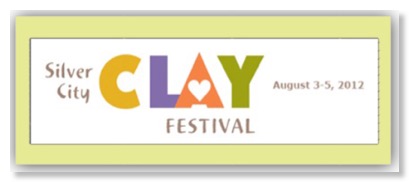
click image or here for details . . .
JOIN TILE HERITAGE!
Send Tile Heritage your ‘Tile Tales’ - Share pictures of interesting installations both historic and contemporary as well as restorations and other tile treasures! Submission guide lines
See who Sponsors Tile Heritage Foundation
Link to a PRINT VERSION of this E-News Link to E-News prior to Spring 2010
Calendar and Upcoming Events
E-News is available regularly to Tile Heritage members and friends.
If your email address has changed, please e-mail from the address you would like us to use.
foundation@tileheritage.org
Not a current THF member? Join us!


